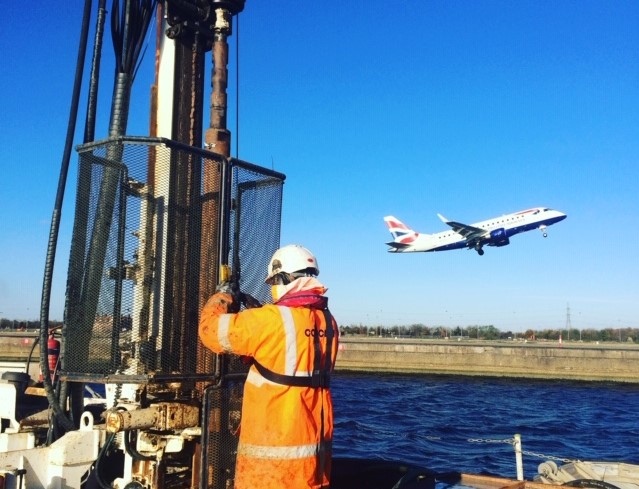Details
The site was located within the boundaries of London City Airport and King George V Dock. The proposed development was the expansion of the airport terminal, apron and taxiways.
The purpose of the geotechnical investigation was to establish the geotechnical ground and groundwater parameters to allow detailed designs to be formulated for the proposed expansion plans.
The scope of the ground investigation comprised:
- 19 No. Cable Percussion Boreholes to a maximum depth of 37.50m;
- 15 No. Rotary Boreholes to a maximum depth of 45.50m;
- 1 No. Machine Excavated Trial Pit to a depth of 2.00m;
- Menard Pressuremeter Testing;
- Resistivity Survey & Testing;
- Geotechnical & Chemical Testing.

Challenges
All of the boreholes with the exception of 1No. borehole were positioned in the King George V Dock to the south of the airport runway.
To compete these overwater boreholes Concept utilised 2 No. separate large floating pontoon platforms each fitted with spud legs.
Each pontoon had on board cable percussive plant and equipment, rotary drilling and coring plant and equipment, all in situ testing equipment and welfare facilities to enable 24hour working.
The pontoons were supported by tug and safety boats for repositioning on each borehole location and were serviced daily by a crew change boat removing samples and replenishing consumables.
The King George V Dock is an operational and busy dock and Concept were in constant liaison with the Port of London and Dock Authorities to ensure there was no disruption to their daily activities. Similarly all our works had to be co-ordinated with London City Airport Authorities so we did no impact upon their busy flight schedules and logistics.
Outcome
Intrusive works: A total of 34 boreholes and a single machine excavated trial pit were safely and successfully completed in accordance with the specification for the works.
Sampling and Logging: Environmental samples (tubs, jars and vials) were taken for chemical analysis in the dock silt, terrace gravels and Made Ground or at each change of strata and where visual or olfactory evidence of contamination was noted or as instructed by the Investigation Supervisor. All samples taken for chemical analysis were screened for volatiles using a Phocheck Tiger photoionization detector.
Bulk samples were taken at regular intervals throughout the boreholes.
Standard Penetration Tests (SPT) were carried out at specified intervals or as otherwise instructed by the Investigation Supervisor. The resulting SPT “N” blow count values are presented in the relevant borehole records. Where an SPT using a split spoon sampler was not possible, due to the granular nature of the material, a solid cone was used.
Small, disturbed samples were retrieved from the SPT split spoon sampler.
Undisturbed Thin Walled samples (UT) were taken in accordance with EC7 using a down-hole sliding hammer in cohesive material at regular intervals or as instructed by the Engineer.
Near-continuous samples were recovered in core runs nominally 1.50m long within semi- rigid plastic liners, sealed at each end after recovery and stored in wooden core boxes.
The semi-rigid plastic liners were split in Concept’s logging cabin on site and the material was geologically logged and photographed immediately following recovery. Selected sub-samples of core were taken at various intervals where possible. The sub-cores were sealed in wax and aluminium foil.
In Situ Testing: A Resistivity Survey to determine the water resistivity and its corrosive nature was carried out in the Dock. The survey comprised water conductivity measurements taken using YSI Pro Multi Probe, at approximately 20m intervals along all dock walls and airfield side edges and recorded. Starting point of the grid for Eastern terminal extension was 1m from the existing MTB and 1m from the dock side. The water resistivity was derived from the conductivity measurements. Overall the project was delivered safely, on time, on budget and to the complete satisfaction of London City Airport Limited.
Location
London
Value
Ground Investigation Value £550k
Designer/Consultant
TPS Consult
Client
London City Airport Ltd